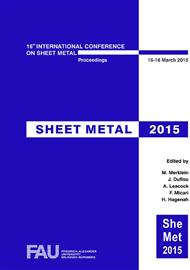p.259
p.267
p.275
p.283
p.291
p.301
p.309
p.317
p.325
Measuring Systems for Sheet-Bulk Metal Forming
Abstract:
In order to fulfil today’s demands on fast, efficient and sustainable production processes the sheet-bulk metal forming is being developed as a new forming technology within the scope of the SFB/Transregio 73. Characteristically for the sheet bulk metal forming is a three dimensional material flow, which allows for extensive freedom in the design process. To ensure maintaining all the advantages, provided by sheet-bulk metal forming, new inspection concepts for the produced parts as well as for the forming tools have to be developed. For a production-related inspection of produced parts a multi-sensor fringe projection system is under development, which will be employed to detect deviations of features’ form and size. With its sensors of varying measuring range and resolution a feature adapted inspection is possible. Additionally an optical fibre sensor is projected to detect small parts of interest in a very high resolution to enhance the possibilities of the multiscale multi-sensor system. A newly developed endoscopic fringe projection system is used to inspect parts that are out of reach for common optical measuring systems such as the forming tool of the process. This allows for a continuous measurement of tool features and thus the detection of slow growing wear. Challenging for measurement tasks in the sheet-bulk metal forming process are not only the complex geometries but also the harsh environmental conditions and especially for the parts’ inspection, the different surface parameters. In this article the surface parameters of the some sheet-bulk metal formed parts and forming tools will be explained, followed by a description of the different measuring systems. Finally an exemplary evaluation of the influence of the surface properties on an optical measuring system will be shown.
Info:
Periodical:
Pages:
291-298
Citation:
Online since:
March 2015
Keywords:
Price:
Сopyright:
© 2015 Trans Tech Publications Ltd. All Rights Reserved
Share:
Citation:


